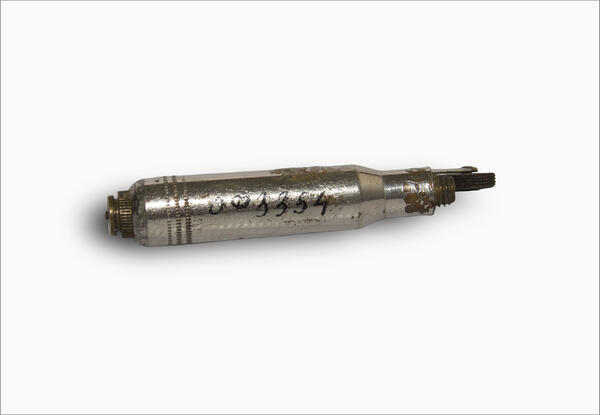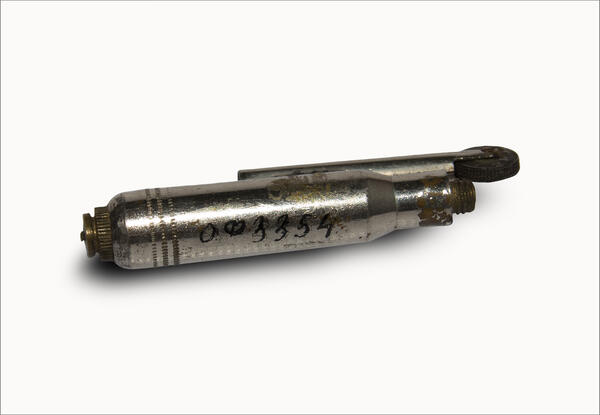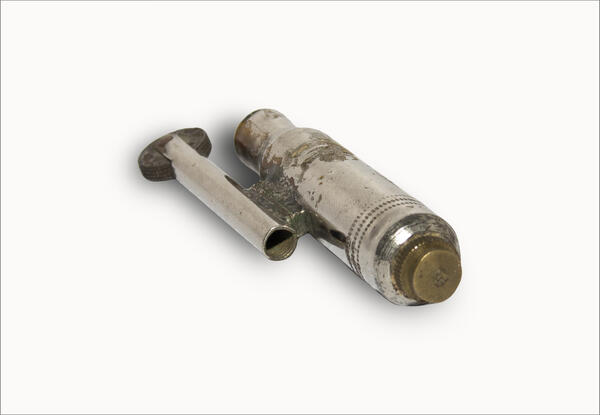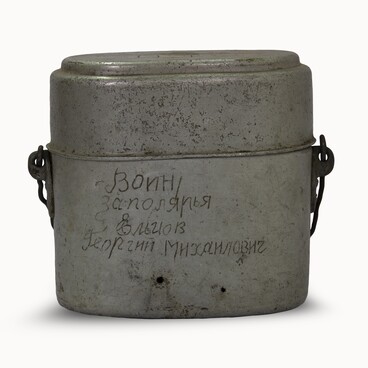The gasoline pocket lighter on display at the exhibition “Tyumen — The War — The Great Victory” once belonged to Nikolay Vasilyevich Sushkov, a well-known Tyumen doctor, an Honored Doctor of the RSFSR. It was donated to the museum of local lore by his widow along with the entire archive of the Tyumen surgeon.
The lighter was made from a cartridge case. It is a nickel-plated cylinder having three grooves along its lower edge. The cylinder was soldered to a hollow metal rod, on which a wheel was fixed. The lighter was made in the first half of the 20th century, most likely during the Great Patriotic War.
During World War II, finding a source of fire could be a matter of life and death. Some soldiers used a tinderbox, but dealing with it required more time, so many sought to get a makeshift lighter. Such specimens were made by soldiers on all fronts in almost any army workshop — improvised from available materials.
There was no shortage of spent cartridges, so they were an obvious material of choice for making lighters. The design was fairly simple. It consisted of a rifle cartridge case, a thin brass tube, which was soldered with tin on the side, and a wheeled steel. A spring and a flintstone were placed inside the tube. A screw to hold the spring in place was screwed into the end of the tube.
The wheel rested on a riveting axle inside a vertical cut in the tube. The capsule socket was drilled out. A suitable screw was screwed into it as a plug. The internal volume of the case was filled with cotton wool; a wick protruded from the neck.
Gasoline was poured either through the plug or through the neck. To prevent gasoline from evaporating, a smaller cartridge case or a bullet (removed from an unfired cartridge) was put on top of the wick. Springs, tubes, and screws were usually obtained from broken military equipment, and the wheeled steel was made from a round file.
Such an improvised pocket lighter had its drawbacks: the gasoline evaporated quickly, and the wheel would occasionally fail to spark, yet the device was still a fairly reliable source of fire, which was essential for soldiers during the war.
The lighter was made from a cartridge case. It is a nickel-plated cylinder having three grooves along its lower edge. The cylinder was soldered to a hollow metal rod, on which a wheel was fixed. The lighter was made in the first half of the 20th century, most likely during the Great Patriotic War.
During World War II, finding a source of fire could be a matter of life and death. Some soldiers used a tinderbox, but dealing with it required more time, so many sought to get a makeshift lighter. Such specimens were made by soldiers on all fronts in almost any army workshop — improvised from available materials.
There was no shortage of spent cartridges, so they were an obvious material of choice for making lighters. The design was fairly simple. It consisted of a rifle cartridge case, a thin brass tube, which was soldered with tin on the side, and a wheeled steel. A spring and a flintstone were placed inside the tube. A screw to hold the spring in place was screwed into the end of the tube.
The wheel rested on a riveting axle inside a vertical cut in the tube. The capsule socket was drilled out. A suitable screw was screwed into it as a plug. The internal volume of the case was filled with cotton wool; a wick protruded from the neck.
Gasoline was poured either through the plug or through the neck. To prevent gasoline from evaporating, a smaller cartridge case or a bullet (removed from an unfired cartridge) was put on top of the wick. Springs, tubes, and screws were usually obtained from broken military equipment, and the wheeled steel was made from a round file.
Such an improvised pocket lighter had its drawbacks: the gasoline evaporated quickly, and the wheel would occasionally fail to spark, yet the device was still a fairly reliable source of fire, which was essential for soldiers during the war.






